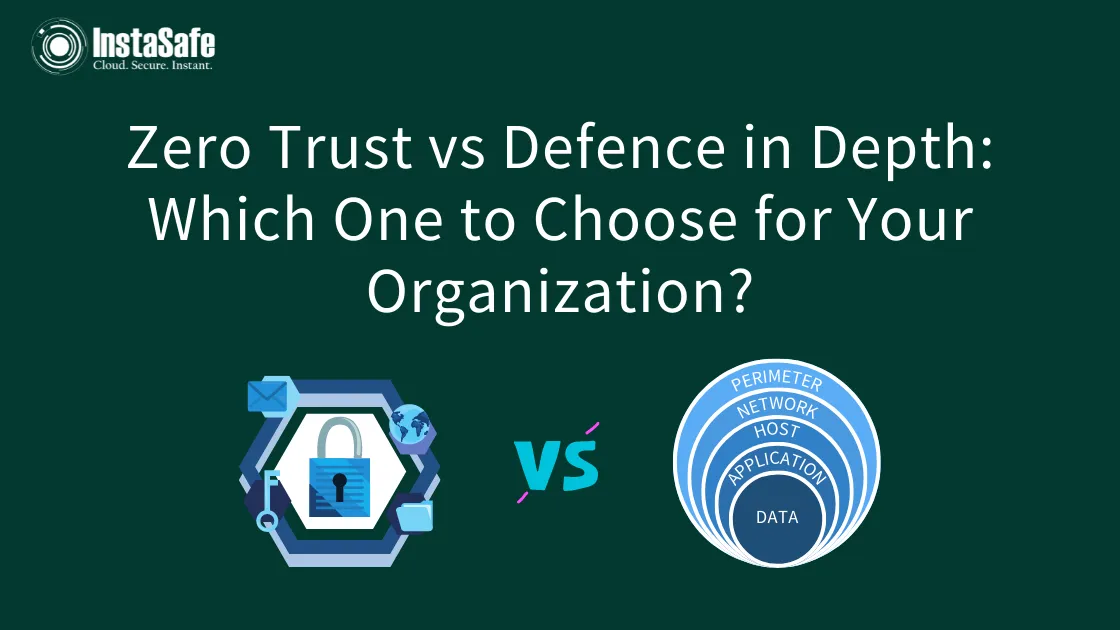Zero Trust vs Defence in Depth: Which One to Choose for Your Organisation?

Choosing a reliable cybersecurity solution that prevents security breaches and ensures secure remote access to employees is highly important.
With the increasing cybersecurity concerns, organisations have started enforcing network security precautions, mainly because the organisation's infrastructure and facilities are the common targets of cyber attackers.
These cyberattacks and ransomware attacks lead to financial losses for organisations along with reputational damage. Hence, employing the right security strategy to prevent these attacks and ensures the utmost network security is paramount.
In this article, we'll see two well-known security solutions:
- Zero Trust Security
- Defence in Depth Security
We'll see what each of these strategies means, their merits and demerits, and which one you should choose to protect your organisation's network.
What Is Defence in Depth?
Defence in Depth (DiD) is a cybersecurity solution that employs multiple security defences layers to protect your network data and systems from cyberattacks.
These Defence in Depth layers make it difficult for cybercriminals and attackers to penetrate the outer layers. And even if attackers get past these layers, the defences layers make it difficult for them to move laterally within the enterprise network and access its sensitive data and resources.
The multiple layers used in the Defence in Depth strategy to secure your internal organisation network from external attackers can be
- Firewalls
- Authentication and intrusion detection systems
- Secured gateways
The major advantage of Defence in Depth is that even if one security layer gets compromised or a part of an enterprise security layer fails, other platforms and networks are still kept safe. Hence, these redundant security layers help ensure that a single point of failure won't make the security breach affect your network security.
However, even this multilayer security strategy comes with disadvantages.
Demerits of Defence in Depth Strategy
Here are the disadvantages of the Defence in Depth security strategy:
- The DiD strategy comes with complex management as it gets difficult to coordinate, maintain, and manage the multiple security defences layers.
- Maintaining, investing, and managing the multiple security layers becomes expensive and adds additional expenses to the organisation's security budget.
- The outer security layers are quite easy to penetrate for today's modern cybercriminals, providing a false sense of security and making it easier for attackers to access the network.
These demerits make today's modern enterprises opt for a much more secure, reliable, and economical security solution, like Zero Trust.
What Is Zero Trust?
Zero Trust Security is a cybersecurity solution that employs the principle of ''Never Trust, Always Verify.'' It helps prevent unauthenticated and unauthorised access to the enterprise network.
Thus, the Zero Trust model emphasises strict authentication and authorisation to grant users, and devices access to network applications and resources to reduce cybersecurity threats and online breaches.
Hence, the Zero Trust Security model prevents internal and external threats with continuous verification and user and device identification to grant network access.
Reasons to Choose Zero Trust Over Defence in Depth for your organisation
Here are the advantages of Zero Trust Security for your enterprise network over Defence in Depth Security solution:
- Zero Trust Network Access creates secure, private, and encrypted tunnels to establish secure connections between users' devices and the network they want to access.
- Zero Trust Security removes excessive trust, employing a default-deny approach to protect your network layer.
- The Zero Trust Network model is much easier to maintain and implement, especially when you opt for it from the right cybersecurity provider.
- Zero Trust enables continuous risk assessment for each user request within the network access solutions.
- Zero Trust is easy to deploy and scale as it's optimised for the cloud.
- With Zero Trust, you get a bird's eye view of your network, with complete visibility over who's accessing what resources; this visibility makes it easier to identify threat vectors and prevent them from harming your enterprise network.
- Zero Trust provides unhindered connectivity, seamless performance, and secure, single-click access to network applications to the end users. In addition, it removes latency and performance degradation issues, providing an excellent user experience.
These benefits make Zero Trust Security an ideal solution for enterprise network security.
Conclusion: The Final Verdict
While Defence in Depth security strategy prevents cyberattacks to some extent, it isn't a much reliable and affordable solution. It increases management and deployment costs and complexity for organisations.
On the contrary, Zero Trust is designed for modern enterprises, providing a cloud-ready, affordable, scalable, easily deployable, secure, and reliable solution to meet the organisation's security needs.
Our InstaSafe Zero Trust Network security minimises your network's attack surface, providing granular access, complete visibility, and passwordless authentication for your enterprise's secure network access solution. So, check out our budget-friendly Zero Trust solutions for your enterprise and book a free demo today.
Key Products
MFA | I&AM | ZTNA | Zero Trust Application Access | Secure Enterprise Browser
Key Features
Single Sign On | Endpoint Security | Device Binding | Domain Joining | Always On VPN | Contextual Based Access | Clientless Remote Access | Device Posture Check
Key Solutions
VPN Alternatives | DevOps Security | Cloud Application Security | Secure Remote Access | VoIP Security
